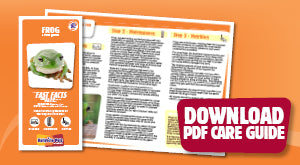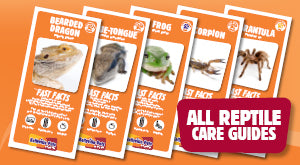 This comprehensive care guide will show you how to look after a Frog in 3 easy steps
This comprehensive care guide will show you how to look after a Frog in 3 easy steps
Fast Facts:
How long will my Frog live? They can live for 15-20+ years
How big will my Frog grow? They will grow 5-12cm
What size of tank is recommended for my Frog? They require aglass terrarium
What does a Frog eat? - Crickets, woodies and silkworms
How easy is it to look after a frog? Frogs are a high maintenance pet
Frogs are kept as pets in NSW. Two of the most popular and adaptable species are the Green Tree Frog, and the White-Lipped Tree Frog.
Frog Housing
Frogs should be kept in a glass terrarium to maintain optimum water/humidity levels, however terrarium size will depend on species and number of frogs you wish to house. Do not over crowd your tank as this can cause frogs to become stressed and they may stop feeding or fall ill.
Enclosures must have secure mesh lids, as frogs are escape experts. An organic substrate such as coco fibre should be used as a base, and large, coarse pebbles can be used in the water areas. The enclosure should be furnished with ornamental rocks, log hides and artificial plants (climbing branches and vines should be included for tree frogs). All furnishings should be smooth, clean and stable to prevent your frog from getting injured or squashed!
Frog Care
Frogs require heating and temperatures will vary depending on species. However, ideal temperatures include water at 24-26˚C, hot spot at 28-30˚C, cool spot at 22-24˚C and ambient at 26˚C. In captivity, heat can be provided through water heaters, infrared or moonlight heat globes, heat mats and cords or ceramic heat emitter. Thermostats must be used to control heat sources and prevent overheating of the enclosure. Temperature in the enclosure should be stabilised prior to moving frogs in. Having a good temperature gradient within your enclosure will allow your frogs to choose their desired temperature (thermoregulation).
There are 3 types of lighting that need to be provided for the health and wellbeing of your frogs. UVA for appetite, development/growth, daily activity and reproduction, UVB for the absorption of vitamin D3/Calcium and white light for natural day and night cycle. Day light hours should be for 10-12 hours and the light should be turned off at night.
Good water quality in your frog enclosure is essential. It is best to use filtered water or tap water for your frogs enclosure, but ensure that a water conditioner is used to remove any harmful chlorine and other chemicals.
Water should be changed daily if provided in a bowl as it may get dirty from drowned insects or by frogs defecating in it. For larger volumes of water, change weekly. A small filter can also be used to maintain water movement and quality. Substrate should also be ‘spot checked’ daily and all faeces removed.
Frogs require a humid environment, so the tank should be misted daily. Ensure the spray bottle contains dechlorinated water only for use in your frog enclosure.
Humidity can also be increased by using a Fogger which creates an attractive natural looking fog. Although humidity is important, dry areas must always be provided. Excess humidity can cause bacteria to build up which can be detrimental to the health of your frogs. A good indication off too much humidity is constant condensation on the glass.
Frog Feeding
Frogs are insectivores, meaning their diet consists entirely of insects. In captivity the most readily fed insects are crickets, silkworms and wood cockroaches (woodies).
For most frogs, the food item needs to be live and moving for it to be accepted as food. Pinky mice can be given to large frogs on occasions, but not on a regular basis as they are too high in protein and cause kidney damage long term.
The required amount of food needed will be determined by the size of the frog and the frequency of feeding.
Young frogs should be fed daily and less often as they mature. Adults should be fed 2-3 insects every 2 days. As frogs are most active at night, feeding should be done at this time. Tong feeding can be useful as you can monitor how much food each frog gets and that they are all getting a fair share.
As a general rule, the size of insect you offer your frogs should be not much larger than the space between the frog’s 2 eyes.
All insects should be dusted with a calcium and vitamin supplement prior to feeding.

All native amphibians are protected in NSW and an Amphibian Keeper's licence must be obtained from the Office of Environment and Heritage to own one as a pet.
Other states throughout Australia also have restrictions and legal requirements, so make sure to do your research.
Did You Know!
Frogs do not drink through their mouth, but instead absorb water through their skin! Their skin is soft and porous which means both air and water can be easily absorbed. When handling your frogs, always have wet hands. Thoroughly wash your hands and rinse twice, then re-wet your hands before touching your frogs or their enclosure.
It is important that the room your enclosure is kept in has clean air with no pollutants such as smoke, perfume and all aerosols - especially NO FLYSPRAY!
We have created a Shopping list to show what you need to look after a Frog:
- Enclosure; 45 x 45 x 60cm minimum
- Substrate
- Fogger/humidifier (optional)
- Filter (optional)
- Artificial plants
- Climbing timber
- Thermometer
- Heating globe and fitting
- UV globe and fitting
- Thermostat
- Timer
- Water heater
- Water conditioner
- Water sprayer
- Crickets
- Woodies
- Silkworms
- Calcium and vitamin supplement powder
- Feeding tongs
- Feeding tub
Common health issues in Frogs
Fungal Diseases: Frogs can develop fungal skin infections if poor husbandry practices are in place and their enclosure is not properly cleaned.
Metabolic Bone Disease: Calcium or vitamin D3 deficiency as a result of incorrect diet and/or lack of or incorrect UV lighting.
Chemical Toxicity: Frogs are extremely sensitive to chemicals due to their semi-permeable skin. This means they should never be exposed to chlorine, disinfectants, fly sprays, deodorants or perfumes.
Red flags
Is your Frog showing any of the signs of disease or illness? If yes, please consult your reptile vet.
- Dull in colour
- Active during the day
- Loss of appetite or refusal of food
- Cloudy eyes
- Stiffness in hind legs
- Abnormal breathing




At Kellyville Pets, we encourage responsible pet ownership.
CARE GUIDE © Copyright 2016 Kellyville Pets - All information found in this care guide is based upon our own experience. The information provided is not the only information available. In any medical situations, you should always consult your vet, including questions regarding your pet's diet.





 This comprehensive care guide will show you how to look after a Frog in 3 easy steps
This comprehensive care guide will show you how to look after a Frog in 3 easy steps


